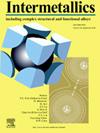Tribological behaviors of a Ni-free Zr-based bulk metallic glass in simulated physiological environments
IF 4.3
2区 材料科学
Q2 CHEMISTRY, PHYSICAL
引用次数: 0
Abstract
Ni-free Zr-based bulk metallic glass (BMG) generally exhibits excellent combination of biocompatibility and mechanical properties, making it a potential candidate for biomedical implants. However, the in-vitro tribological behaviors and wear resistance of Zr-based BMGs still remain less understood. In this study, the wear process of a Ni-free biocompatible Zr60.14Cu22.31Al9.7Fe4.85Ag3 BMG in 3 simulated physiological environments, i.e., deionized (DI) water, 0.9 wt% NaCl solution, and phosphate buffer saline (PBS) solution, are studied using Si3N4 ceramic as the counter-material. The results indicate that Zr60.14Cu22.31Al9.7Fe4.85Ag3 BMG show a specific wear rate less than 1/3 of Ti6Al4V alloy in all the 3 simulated physiological environments, which also surpasses currently reported wear resistance of Zr-based BMGs in the same environments. Specifically, the wear process of Zr60.14Cu22.31Al9.7Fe4.85Ag3 BMG shows a 3-staged character, i.e., the running stage, the transition stage, and the dynamic stable stage, with the main wear mechanism transiting from adhesive wear to coexistence of adhesive wear and oxidative wear, and eventually to oxidative wear. During the transition of wear mechanism, the formation of oxide layer on the worn surface plays the key role, which provides protection against wear and leads to better wear resistance. Notably, the relatively higher wear rate of Zr60.14Cu22.31Al9.7Fe4.85Ag3 BMG in 0.9 wt% NaCl solution and PBS solution than that in DI water is attributed to the corrosivity of wear environments, which weakens the adhesion between oxide layer and BMG substrate thus promoting spalling of oxide layer and enhancing wear degradation. These results indicate the synergistic effect of corrosion and wear in Zr-based BMG in simulated physiological environments. Our work provides insights in developing wear-resistant Zr-based BMGs for implantable biomaterials.
求助全文
约1分钟内获得全文
求助全文
来源期刊

Intermetallics
工程技术-材料科学:综合
CiteScore
7.80
自引率
9.10%
发文量
291
审稿时长
37 days
期刊介绍:
This journal is a platform for publishing innovative research and overviews for advancing our understanding of the structure, property, and functionality of complex metallic alloys, including intermetallics, metallic glasses, and high entropy alloys.
The journal reports the science and engineering of metallic materials in the following aspects:
Theories and experiments which address the relationship between property and structure in all length scales.
Physical modeling and numerical simulations which provide a comprehensive understanding of experimental observations.
Stimulated methodologies to characterize the structure and chemistry of materials that correlate the properties.
Technological applications resulting from the understanding of property-structure relationship in materials.
Novel and cutting-edge results warranting rapid communication.
The journal also publishes special issues on selected topics and overviews by invitation only.
 求助内容:
求助内容: 应助结果提醒方式:
应助结果提醒方式:


